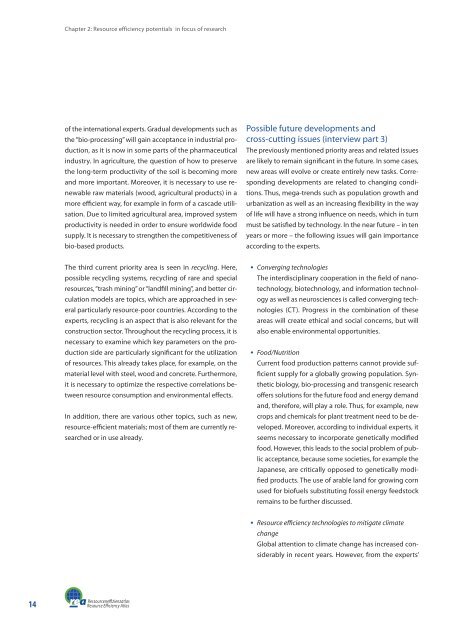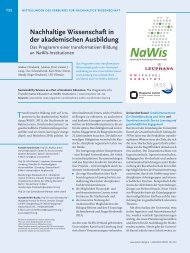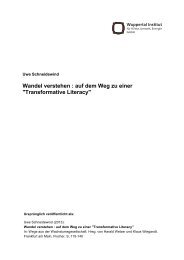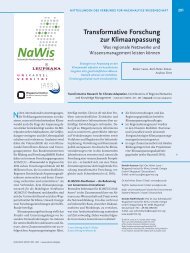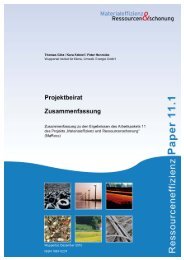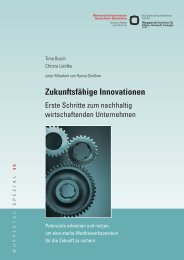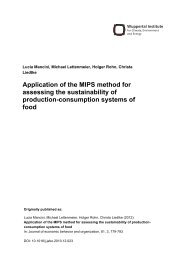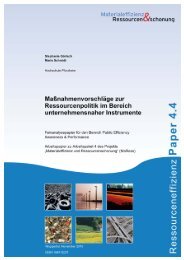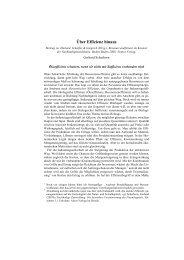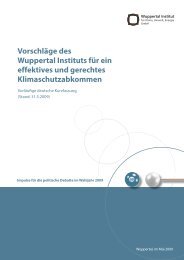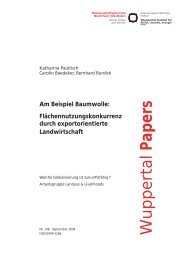Resource Efficiency Atlas - Publication Server of the Wuppertal ...
Resource Efficiency Atlas - Publication Server of the Wuppertal ...
Resource Efficiency Atlas - Publication Server of the Wuppertal ...
Create successful ePaper yourself
Turn your PDF publications into a flip-book with our unique Google optimized e-Paper software.
14<br />
Chapter 2: <strong>Resource</strong> efficiency potentials in focus <strong>of</strong> research<br />
<strong>of</strong> <strong>the</strong> international experts. Gradual developments such as<br />
<strong>the</strong> “bio-processing” will gain acceptance in industrial pro-<br />
duction, as it is now in some parts <strong>of</strong> <strong>the</strong> pharmaceutical<br />
industry. In agriculture, <strong>the</strong> question <strong>of</strong> how to preserve<br />
<strong>the</strong> long-term productivity <strong>of</strong> <strong>the</strong> soil is becoming more<br />
and more important. Moreover, it is necessary to use renewable<br />
raw materials (wood, agricultural products) in a<br />
more efficient way, for example in form <strong>of</strong> a cascade utilisation.<br />
Due to limited agricultural area, improved system<br />
productivity is needed in order to ensure worldwide food<br />
supply. It is necessary to streng<strong>the</strong>n <strong>the</strong> competitiveness <strong>of</strong><br />
bio-based products.<br />
The third current priority area is seen in recycling. Here,<br />
possible recycling systems, recycling <strong>of</strong> rare and special<br />
resources, “trash mining” or “landfill mining”, and better circulation<br />
models are topics, which are approached in several<br />
particularly resource-poor countries. According to <strong>the</strong><br />
experts, recycling is an aspect that is also relevant for <strong>the</strong><br />
construction sector. Throughout <strong>the</strong> recycling process, it is<br />
necessary to examine which key parameters on <strong>the</strong> production<br />
side are particularly significant for <strong>the</strong> utilization<br />
<strong>of</strong> resources. This already takes place, for example, on <strong>the</strong><br />
material level with steel, wood and concrete. Fur<strong>the</strong>rmore,<br />
it is necessary to optimize <strong>the</strong> respective correlations between<br />
resource consumption and environmental effects.<br />
In addition, <strong>the</strong>re are various o<strong>the</strong>r topics, such as new,<br />
resource-efficient materials; most <strong>of</strong> <strong>the</strong>m are currently researched<br />
or in use already.<br />
Ressourceneffizienzatlas<br />
<strong>Resource</strong> <strong>Efficiency</strong> <strong>Atlas</strong><br />
Possible future developments and<br />
cross-cutting issues (interview part 3)<br />
The previously mentioned priority areas and related issues<br />
are likely to remain significant in <strong>the</strong> future. In some cases,<br />
new areas will evolve or create entirely new tasks. Corresponding<br />
developments are related to changing conditions.<br />
Thus, mega-trends such as population growth and<br />
urbanization as well as an increasing flexibility in <strong>the</strong> way<br />
<strong>of</strong> life will have a strong influence on needs, which in turn<br />
must be satisfied by technology. In <strong>the</strong> near future – in ten<br />
years or more – <strong>the</strong> following issues will gain importance<br />
according to <strong>the</strong> experts.<br />
Converging technologies<br />
The interdisciplinary cooperation in <strong>the</strong> field <strong>of</strong> nano-<br />
technology, biotechnology, and information technol-<br />
ogy as well as neurosciences is called converging tech-<br />
nologies (CT). Progress in <strong>the</strong> combination <strong>of</strong> <strong>the</strong>se<br />
areas will create ethical and social concerns, but will<br />
also enable environmental opportunities.<br />
Food/Nutrition<br />
Current food production patterns cannot provide suf-<br />
ficient supply for a globally growing population. Syn-<br />
<strong>the</strong>tic biology, bio-processing and transgenic research<br />
<strong>of</strong>fers solutions for <strong>the</strong> future food and energy demand<br />
and, <strong>the</strong>refore, will play a role. Thus, for example, new<br />
crops and chemicals for plant treatment need to be de-<br />
veloped. Moreover, according to individual experts, it<br />
seems necessary to incorporate genetically modified<br />
food. However, this leads to <strong>the</strong> social problem <strong>of</strong> pub-<br />
lic acceptance, because some societies, for example <strong>the</strong><br />
Japanese, are critically opposed to genetically modi-<br />
fied products. The use <strong>of</strong> arable land for growing corn<br />
used for bi<strong>of</strong>uels substituting fossil energy feedstock<br />
remains to be fur<strong>the</strong>r discussed.<br />
<strong>Resource</strong> efficiency technologies to mitigate climate<br />
change<br />
Global attention to climate change has increased considerably<br />
in recent years. However, from <strong>the</strong> experts’


